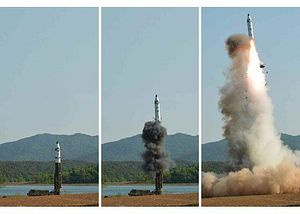U.S. President Donald Trump is presumably hurtling toward a historic summit with North Korean leader Kim Jong-un. Since he was visited last week by two of South Korean President Moon Jae-in’s envoys, Trump appears to be under the impression that Kim has credibly made a promise to put denuclearization on the table during the summit — if it happens — and to refrain from any nuclear and missile testing during the preparation for the summit.
On Saturday, Trump took to Twitter to underline that “North Korea has not conducted a Missile Test since November 28, 2017 and has promised not to do so through our meetings.” He added that he believes “they will honor that commitment!” Trump is correct that North Korea hasn’t flight-tested any missiles since the November 2017 test of the Hwasong-15 intercontinental-range ballistic missile, the first North Korean missile that would be capable of comfortably ranging the entire continental United States if flown on a normal trajectory.
However, as I noted last week, it’ll be important for the administration to wrap its head around what behaviors it is willing to tolerate — if any — as part of Kim Jong-un’s presumed missile testing freeze. There are plenty of activities that North Korea could conduct under the threshold of a missile flight test that the Trump administration may perceive as unacceptable. While the administration has every right to set the terms for what activities it’ll tolerate, what’s dangerous is leaving the terms ambiguous.
A cautionary note here is the infamous 2012 “Leap Day” agreement, the Obama administration’s one productive diplomatic dalliance with North Korea. Following “exploratory” talks in Beijing, just months after Kim Jong-un’s father Kim Jong-il had died, the United States and North Korea arrived at a modest agreement: North Korea would submit to “a moratorium on long-range missile launches, nuclear tests and nuclear activities at Yongbyon, including uranium enrichment activities.” In exchange, North Korea would receive food aid. Had the agreement succeeded, it may have paved the path toward further diplomatic exchange.
Instead, a little more than two weeks after the agreement had been concluded, North Korea announced plans for a new satellite launch and ended up going through with the launch. For Pyongyang, satellite launches were distinct from ballistic missile activities, even though the United States recognized the technological and knowledge overlap between the two fields. In April 2012, North Korea launched a failed satellite launch vehicle and the agreement fell apart.
Even though the Obama administration’s negotiators had walked away with one understanding of the agreement, North Korea had a different interpretation. This may yet play out again this year. As the United States and South Korea head into their annual Foal Eagle exercises — something Kim Jong-un reportedly told South Korean negotiators that he will tolerate — North Korea may choose to carry out its own military readiness drills and perhaps even test missile components.
What will the United States stand for short of the flight-testing of ballistic missiles? Even if Pyongyang is unlikely to launch the Hwasong-15 or Hwasong-14 ICBMs, the Hwasong-12 intermediate-range ballistic missile, the Pukguksong-2 and Pukguksong-1 solid-fuel missiles, its Scuds, extended-range Scuds, and Nodongs, understanding these systems to be strategic provocations, it may carry out other tests.
North Korea could test its short-range Toksa missiles — including a new variant it appeared to show off at its February 2018 military parade. It could also use its multiple launch rocket systems (MLRS) for exercises during Foal Eagle. Similarly, Kim may choose to authorize ejection tests for the country’s submarine-launched ballistic missiles, or new static engine tests — developmental activities clearly related to the country’s ballistic missile programs.
It’s doubtful that a Trump-Kim summit will end up happening by May, as the South Koreans have suggested. Given the administration’s ambiguity and a lack of direct assurances from North Korea, it’s mighty likely that Pyongyang will behave in a way that the Trump administration finds to be insufficiently demonstrative of good faith intent. That could end up scuttle whatever progress in currently underway unless the administration clarifies its expectations in more precise terms.

































